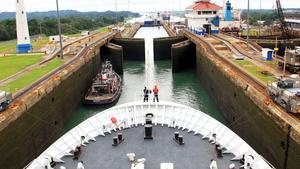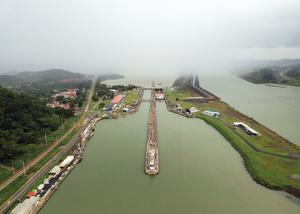Economic cooperation with China grows despite political, social turbulence across the continent
 The Chinese naval hospital ship Peace Ark passes through the Panama Canal in 2011. (ZHA CHUNMING / XINHUA)
The Chinese naval hospital ship Peace Ark passes through the Panama Canal in 2011. (ZHA CHUNMING / XINHUA)
Last year was one of political and social upheaval in South America, but the continent also made economic progress.
In Venezuela, President Nicolas Maduro survived an attempted coup in January led by opposition leader Juan Guaido.
Neighboring Colombia has taken most of the refugees fleeing Venezuela.
In Bolivia, President Evo Morales, who was the country’s first indigenous president, resigned in November after a contested election.
In Chile, an increase in transit fares in the capital Santiago fueled days of violent protests that led to other demands. Protesters also hit out at the rising cost of living, privatization and inequality.
Many people have worried that the political uncertainty in Latin America may have affected economic cooperation between China and the continent. However, in the first half of 2019, trade between China and Latin America reached US$147.1 billion, up 1.3 percent year-on-year, according to the General Administration of Customs.
To date, 19 Latin American countries have signed cooperation agreements for the Belt and Road Initiative, proposed by President Xi Jinping in 2013.
Meanwhile, Chile is forecasting record cherry exports this season, mainly driven by consumer demand in China, which accounted for 88 percent of the country’s exports of the fruit last season.
In Argentina, the newly inaugurated administration of Alberto Fernandez has pledged a series of measures to bolster the economy and domestic consumption, while reining in inflation through a social pact with various organizations.
Fernandez has announced an increase in levies on agricultural exports and is set to raise taxes on purchases abroad and rates paid on properties in an attempt to bolster funds to pay for increased social subsidies.
Argentine Health Minister Gines Gonzalez Garcia said after a meeting with industry representatives and Fernandez, “This does not solve all the problems, but it does improve everyone’s ability to access medicines.”
The country’s economy is facing annual inflation of close to 55 percent and poverty levels of nearly 40 percent. Argentina, which is Latin America’s third-largest economy, also needs to restructure a large amount of sovereign debt with creditors.
 A bird’s-eye view of the canal. (PHOTO / XINHUA)
A bird’s-eye view of the canal. (PHOTO / XINHUA)
China investing
Fernandez may have to deal with sharing attention with leftist populist Cristina Fernandez de Kirchner, the nation’s former president and now vice-president, who some observers say will be the power behind the new government.
Trade between China and Argentina was valued at US$16.5 billion in 2018, with two-thirds of it comprising exports to China, according to official Argentine figures.
The International Monetary Fund expected Argentina’s economy to have shrunk by 3.1 percent last year, with inflation above 50 percent.
The country’s debt-to-GDP ratio has soared to 93 percent, with the IMF coming to its aid with US$57 billion in 2018, despite Argentina having defaulted on US$93 billion of debt in 2001.
For its part, China is investing in infrastructure in Argentina.
China Gezhouba Group, a construction company based in Wuhan, Hubei province, has led the building of two hydroelectric dams and a new tunnel connecting Argentina and Chile in the Patagonia region.
In December, China and Argentina signed a deal for the export of Argentine lemons.
In Ecuador, the government faced swift backlash in October after it scrapped fuel subsidies, forcing the leadership to quickly retract the measure.
In Peru, President Martin Vizcarra dissolved a congress resisting his anti-corruption reforms and now has to cope with lawmakers who want to shorten his presidency.
In Brazil, President Jair Bolsonaro, who was critical of China during his election campaign, has become more open to doing business with the world’s second-largest economy.
Mauricio Santoro, an assistant professor in the Department of International Relations at the State University of Rio de Janeiro, said: “The deep ties of Sino-Brazilian relations are part of a general trend that is making the whole region more important to China.
“In the 2000s, the big news was the rise in trade. In the 2010s, it was also about Chinese investment in Latin America and several countries in the region joining the Belt and Road Initiative.
“As we head into the 2020s, the perspective is that China will play an even more important role in the Brazilian economy, and this is why President Bolsonaro changed course in the first year of his administration, leaving behind his former harsh criticism of China and adopting a pragmatic approach.”
Santoro said that last year Brazilian exports to China grew substantially, especially in the agribusiness sector. China bought more soybeans from Brazilian producers, because of the trade conflict with the United States. The agreement for the “phase one” trade deal is expected to result in China buying more agricultural products from the US, including soybeans.
Santoro said that an outbreak of African swine fever in China saw the nation import much more pork from Brazil.
He added that the Bolsonaro administration is showing signs that it will not bow to US pressure to place sanctions on Chinese tech companies, and it looks as if Huawei will be able to take part in the 5G internet auction that will likely take place sometime this year.
The privatization process announced by the Brazilian government will be vital for Chinese companies, especially State Grid, Santoro said. State Grid is already a major player in Brazil’s energy market and is a likely buyer for Eletrobras, Brazil’s giant state-owned utility enterprise.
Santoro said public opinion in Brazil is positive toward China, and Brazilians see their country as a major economic partner and a rising power. He added that Brazilians are wary of US President Donald Trump, who recently accused Brazil and Argentina of devaluing their currencies.
“There is interest and respect for Chinese culture, and this feeling is particularly strong among young people,” Santoro said.
In Colombia, President Ivan Duque in November praised the signing of a contract with APCA Transmimetro, a Chinese railway construction consortium, to build the first subway line in Bogota, the capital.
“Bogota has been dreaming of this for decades. Today, we take another step, and I would say that it is the most important — the signing of the contract,” Duque said.
“The formal construction of the subway starts now. The transformation of our capital starts now. The largest investment in the history of the city starts now.”
Presiding over the signing ceremony at the presidential headquarters in Bogota, Duque said the project is set to deepen collaboration between China and Colombia in infrastructure development.
“I am sure that the successful construction of Bogota’s subway will open frontiers to more projects,” he said, noting that the event coincided with the 40th anniversary of ties between the two countries.
He also said that during a visit to China in July, he and Chinese officials spoke of the importance of “having more Chinese companies wanting to come to Colombia to invest in infrastructure projects”.
 An increase in transit fares in the Chilean capital Santiago led to violent protests in December. (PHOTO PROVIDED TO CHINA DAILY)
An increase in transit fares in the Chilean capital Santiago led to violent protests in December. (PHOTO PROVIDED TO CHINA DAILY)
60,000 jobs
The World Bank, the Inter-American Development Bank and the European Investment Bank are also taking part in the subway project, which is expected to generate some 60,000 jobs, according to Duque.
APCA Transmimetro, comprising China Harbour Engineering Co and Xi’an Metro Co, will be involved in all aspects of the project, from design to partial financing, to building the stations and supplying the trains, and operating the system for 20 years.
In Uruguay, meat processors are looking to increase beef exports to China.
Federico Stanham, head of the National Meats Institute, or Inac, in Uruguay, said that developing brand recognition among Chinese consumers is a “topic that interests us very much”.
“Countries that have positioned their brand, such as Australia, have achieved 25 percent higher sales in meats than we have,” he said. “Led by Inac, Uruguay has, since April, launched a strong promotional campaign in China on social networks, at points of sale and at food distributors and producers.”
The campaign is aimed at making the “Uruguay brand” better known in China, a destination for some 60 percent of the country’s beef exports.
Last year, Uruguay exported about 446,000 metric tons of beef, generating revenue of US$1.72 million, with China buying 294,000 tons worth US$1.01 million.
Panama, a country that connects Central America and South America and shares a border with Colombia, can be a key player in the Belt and Road Initiative, according to a Panamanian business leader.
Giovanni Ferrari, general manager of Panama’s Colon Free Trade Zone, told Xinhua News Agency in December that China and Panama have “much to explore” within the framework of Colon, the largest free-trade zone in the Americas with some 2,600 companies.
Ferrari was speaking on the sidelines of the 13th China-Latin America and the Caribbean Business Summit in Panama City.
Championing free trade
Already home to some 50 Chinese companies, Colon can provide more businesses from the country with the facilities they need to expand their manufacturing, distribution and services to Latin America within the BRI framework, he said.
Ferrari said that in the 1950s, Colon mainly attracted investment from European companies, especially in the pharmaceutical sector. In the 1970s, Japanese electronics companies moved into the area, and in the 1990s, South Korean corporations in the same field arrived.
After 2010, Chinese companies began to enter Colon, Ferrari said. “China and Panama have a historic responsibility to champion free trade or free access to the markets,” he said.
Such a partnership would benefit not only the two countries but consumers and the world as a whole, he said.
In December 2018, President Xi made the first state visit by a leader of the People’s Republic of China to Panama. In Panama City, he urged the business communities in China and Panama to expand cooperation and achieve common development.
China is the second-largest client of the Panama Canal after the US. In June 2016, the Chinese container ship Andronikos became the first vessel to pass through the newly expanded Panama Canal.
In 1854, a ship carrying Chinese workers, many from Guangdong province, docked in Panama in preparation for work on the Panama Canal Railway.
More than 300,000 people of Chinese descent live in Panama, accounting for 10 percent of the population, according to the Overseas Chinese Affairs Office of the State Council, and the Central American country’s connection with China dates to the Qing Dynasty (1644-1911).
It is estimated that some 80 percent of Chinese residents in Panama come from Huadu, Guangdong, where some settlements are nicknamed “Panama Village” due to the high number of locals who have migrated to the Latin American nation.
Xinhua contributed to this story.
Contact the writers at hengweili@chinadailyusa.com


